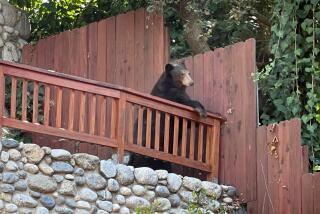Rancher Refuses to Grin and Bear It as Livestock Become Prey
- Share via
NARROW CAPE, Alaska — Bill Burton is a buffalo rancher, but he didn’t get into it on a cholesterol-correct marketing whim. He started raising the shaggy-shouldered critters after hundreds of his cattle became bear bait on this wild corner of Kodiak Island.
Bison are herd animals--wild, big and protective. They don’t take kindly to predators trying to pick off their young.
“They crowd up when threatened,” Burton said. “They don’t hesitate to use their horns. Calves pretty much go to the center of the herd. When they run, they run as a herd. Cattle just aren’t that alert.”
Burton, his wife, Kathy, and son, Buck, hold state grazing rights to around 24,000 acres--a broad swath of scenery-rich territory that includes 3,000-foot mountains, prime salmon streams, oceanfront cliffs, fossil-laden beaches and lupine-rich meadows.
His operation, which fronts the Pacific Ocean and is 50 miles from the nearest community of Kodiak, is something of an anomaly in Alaska, where livestock production isn’t much of an industry.
The Burtons have been raising cattle on Narrow Cape since 1967. They started with Angus and Herefords, then moved to a mix of Charolais, Belted Galloway, Scottish Highlanders and even a couple of longhorns to see if they could find a breed more bear-resistant.
None passed the test. Not even the well-armed longhorns.
From a high of 700 cattle, they’ve reduced the herd to around 60 head. Along the way, someone suggested that they try raising buffalo. They brought up the first of their bison from Wyoming in 1980; the herd now numbers more than 200.
Blame that change in emphasis on the Kodiak bear--a fast, wily hunter that is anything but endangered in this region of Alaska.
Wildlife managers believe that there’s at least one bear per square mile or 1 1/2 miles on this Connecticut-sized island, 250 miles south of Anchorage.
“The Kodiak bear is a generic term for coastal brown bears,” said Roger Smith, an Alaska Department of Fish and Game biologist. “They come in all colors of the wildlife rainbow here--mostly dark brown, with some females more blondish.”
The largest of Kodiak’s male bears weighs upward of 1,500 pounds and stands nearly 10 feet tall. Their front paws, with curved claws that can extend 3 1/2 inches, are strong enough to break a bull’s back.
Bear tracks larger than a man’s size 12 boot aren’t uncommon along stream beds or threaded through the alder-thick ravines on Burton’s ranch. The picked-over carcass of a 3-month-old kill, a mature Scottish Highlander cross, lies abandoned less than a mile from the family’s two-story frame house.
Burton compares the way bears take after livestock to cats toying with mice. “If a bear gets around cattle, eventually he’ll kill one,” he said. “Some just become killer bears.”
The weather is wet and windy but mild on Kodiak Island, meaning bears don’t always den up in winter. If they do hibernate, it’s often for short periods.
“They come out when it warms up,” Burton said. “I’ve lost cattle at all times of the year.”
Predation is simply another of the risks ranchers take in Alaska. But there are losses, and then there are losses.
“One year, out of 600 cattle, we lost well over 100 head--probably 125 head, to bears,” Burton said. “One bear killed seven cattle in just one night. On average, we’ve had about 25 to 30 bear kills a year.”
That tends to gut the Kodiak Cattle Co.’s already lean profit margin, since a mature steer prices out at around $500 to $700, Burton said. “It doesn’t take much of that to put you out of business.”
Enter the bison, which have been all but immune to bear attacks on the Burton ranch. Bill thinks he’s lost at most three or four buffalo to bears since the early 1980s.
“They’ve bred all the smarts out of cattle. Buffalo are still pretty savvy,” he said.
Like most grazer and meat-eater relationships, bison and bears have had a long and uneasy time of it in the American West. But it may not have been as deadly as the writers of the purple sage would have us believe.
“You read in the old Western stories that the bears killed bison . . . that they actually hunted buffalo,” said Charles Jonkel, a retired biologist from Missoula, Mont. “But it may have been mostly misinterpretations.
“Bears are carrion eaters. They may have been just cleaning up on bison that had drowned or had died in falls or some other way,” Jonkel said.
There hasn’t been a single known instance of a bear killing an adult bison at Yellowstone National Park, said John Varley, the park’s chief biologist.
“The effect on calves would be pretty small as well,” Varley said. “Bison have very good predation-avoidance behavior. They circle the wagons when threatened, like musk oxen. They’re very formidable.”
Burton said he eventually plans to build his bison herd to 400 head and add some elk. He intends to sell some for meat and offer guided hunts for a few of his trophy-sized animals.
“Buffalo meat is lean, it doesn’t marble,” Burton said. “It’s great for people who want to avoid cholesterol. It’s also higher in protein. Elk is the same way.”
No matter what game animal mix the Burtons raise on their ranch, Kodiak’s big brown bears will remain a major part of the equation.
“The concentration of biomass there is in so small an area that, if you’ve got a bear that can smell all that--and their noses are their strongest asset--it will be hard for them to pass up,” said Fish and Game’s Smith.
More to Read
Sign up for Essential California
The most important California stories and recommendations in your inbox every morning.
You may occasionally receive promotional content from the Los Angeles Times.













